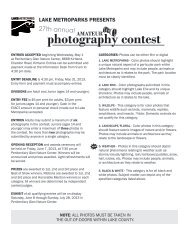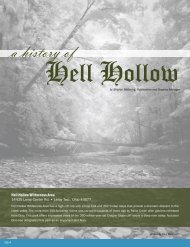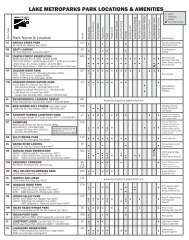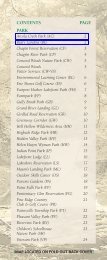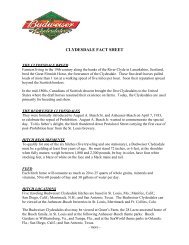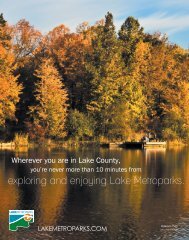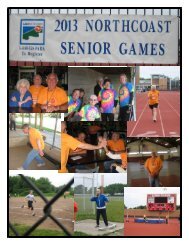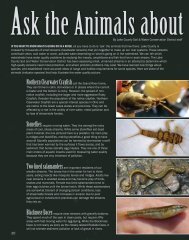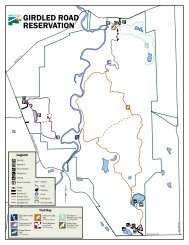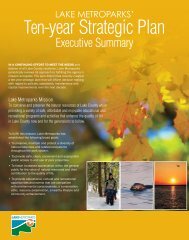Girdled Road Reservation - Lake Metroparks
Girdled Road Reservation - Lake Metroparks
Girdled Road Reservation - Lake Metroparks
You also want an ePaper? Increase the reach of your titles
YUMPU automatically turns print PDFs into web optimized ePapers that Google loves.
the<br />
evolution<br />
of Skok Meadow<br />
filling drill<br />
with seed blends<br />
Article and photos by Tom Adair, Natural Resource Manager<br />
For much of the last century, the property<br />
now called Skok Meadow had been in agricultural<br />
production. This area, situated along <strong>Girdled</strong> <strong>Road</strong><br />
<strong>Reservation</strong>’s western boundary, was home to prized<br />
cattle and a large expanse of cool season grasses<br />
on which they would graze. Today, the site is <strong>Girdled</strong><br />
<strong>Road</strong> <strong>Reservation</strong>’s newest park entrance and home<br />
to a roughly 30-acre grassland complex perched just<br />
above the Big Creek Valley.<br />
Pasture lands all across Ohio are being left to revert<br />
back to old field areas as once larger farmsteads<br />
are sold off and broken into smaller parcels for<br />
development. If residential development pressure<br />
does not consume these lands, they can spend<br />
successive decades “growing up.” This form of<br />
vegetative succession can result in an increase in<br />
plant and animal biodiversity over time. Agricultural<br />
lands represent an important piece in the regional<br />
habitat puzzle. These areas are utilized by grassland<br />
specialists such as bobolinks, meadowlarks<br />
and numerous butterfly species. Land that is in<br />
active agricultural production can sometimes<br />
have a diminished value to wildlife as a result of<br />
interruptions by multiple hay cuttings that destroy<br />
nesting habitat. An intact and largely uninterrupted<br />
open meadow habitat is an increasingly important<br />
habitat type for these plant and wildlife populations.<br />
<strong>Lake</strong> <strong>Metroparks</strong> has decided to take an active<br />
approach to enhancing the habitat at Skok Meadow.<br />
Allowing the former pasture to revert back to<br />
meadow on its own would eventually result in a more<br />
diverse plant community, however this would be a<br />
relatively slow process. Our plan is to establish a mix<br />
of warm season grasses and forbs (flowering plants)<br />
on the site within a period of five to seven years, with<br />
periodic management.<br />
Beginning in the summer of 2010 and continuing<br />
into the fall, several herbicide applications were<br />
made to nearly 22 acres of the total 30-acre<br />
grassland complex. These applications of a low<br />
persistence herbicide were completed so that<br />
existing cool season weeds were eliminated from<br />
the site. The elimination of these existing plants set<br />
the stage by creating appropriate conditions for a<br />
seeding finished in November 2010.<br />
<strong>Lake</strong> <strong>Metroparks</strong> used herbicide rather than tillage<br />
practices so that we would not disturb the underlying<br />
seedbank, which could lead to greater competition<br />
for the young meadow seedlings that will begin to<br />
emerge in spring 2011. The practice also leaves the<br />
soil layer intact and reduces the potential for the<br />
erosion that often accompanies tillage practices. This<br />
was an important management consideration for<br />
a site directly adjacent to the Big Creek Valley and<br />
watershed.<br />
<strong>Lake</strong> <strong>Metroparks</strong> contracted with Ohio Prairie Nursery<br />
(Hiram, Ohio) to create two custom seed blends and<br />
carry out the planting of the seed. One seed blend<br />
was mixed to accommodate the dryer, upland areas<br />
and the other was more suited to the persistently<br />
wet areas of the meadow. Each blend contains a<br />
mixture of dozens of grasses and forbs that should<br />
result in a highly diverse meadow over time. The<br />
upland mix contained grasses like Indian Grass as<br />
well as a variety of forbs including Purple Coneflower<br />
and Black-eyed Susan. The wet areas will give rise<br />
to plants like Big Bluestem, Brown Fox Sedge, Ohio<br />
Spiderwort and Grey-headed Coneflower.<br />
A dormant season planting was completed in<br />
November 2010 by Ohio Prairie Nursery using a<br />
no-till seed drill over most of the area (areas that<br />
remained too wet at the time of seeding were planted<br />
by manually broadcasting the seed). The no-till<br />
method ensures that the seed is drilled down to the<br />
appropriate depth to spend the winter preparing<br />
itself for eventual spring germination and emergence.<br />
In addition to reducing soil erosion, no-till seeding<br />
conserves moisture already present in the seedbed<br />
and also requires less time and fuel than traditional<br />
tillage-based practices.<br />
herbicide<br />
Within the next few years the field will begin to show<br />
an emerging mosaic of the seeded grasses and<br />
forbs. In time, any gaps will begin to fill in as seeds<br />
drop from the established plants and the establishing<br />
plants begin to spread out. Throughout this period,<br />
<strong>Lake</strong> <strong>Metroparks</strong> staff will monitor the vegetative<br />
succession and manage any invasive or unwanted<br />
species that may be present. By the third year of<br />
the meadow establishment, fire will be applied as a<br />
management tool by burning the meadow and then<br />
continuing to burn on a three to five year rotational<br />
basis. Grasslands coevolved with disturbances like<br />
fire and many of the plant species are stimulated<br />
by periodic burns. In addition to promoting the<br />
desirable plant species, these controlled burns<br />
tend to discourage the growth and establishment of<br />
competing cool season weeds.<br />
The eventual progression from a field predominated<br />
by several cool season weed species to the<br />
establishment of a biologically diverse meadow<br />
habitat with dozens of representative grasses and<br />
flowering plants is a slow and unpredictable process<br />
if nature takes its own course. With a little planning<br />
and some human intervention, we can urge that<br />
progression along slightly. In the end, we arrive at<br />
a similar place, but taking an active role can allow<br />
more generations to witness the ecological benefits<br />
of these dynamic habitats—more birders witnessing<br />
their first spring migration, more children seeing their<br />
first Praying Mantis climbing a Goldenrod stalk and<br />
perhaps, more people willing to mimic these same<br />
habitats in their own backyards!<br />
no-till seed drill<br />
on tractor<br />
18<br />
19



